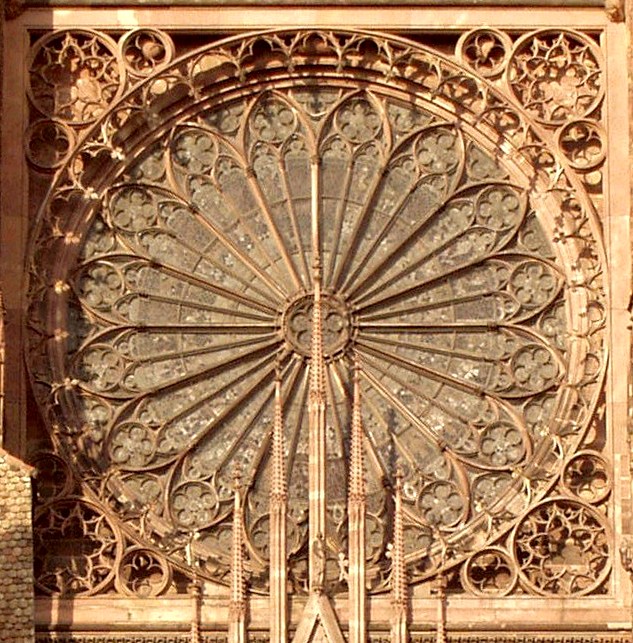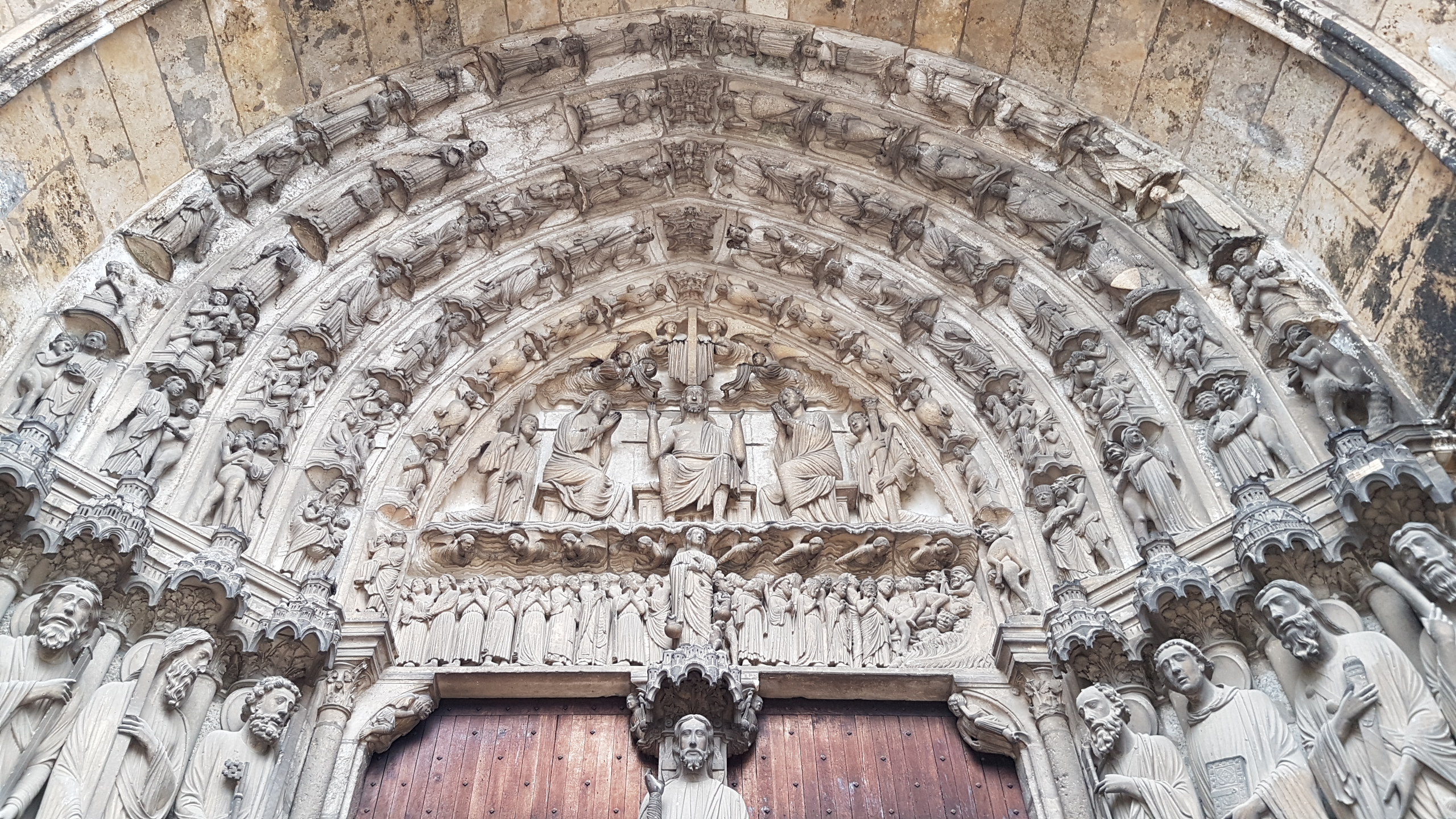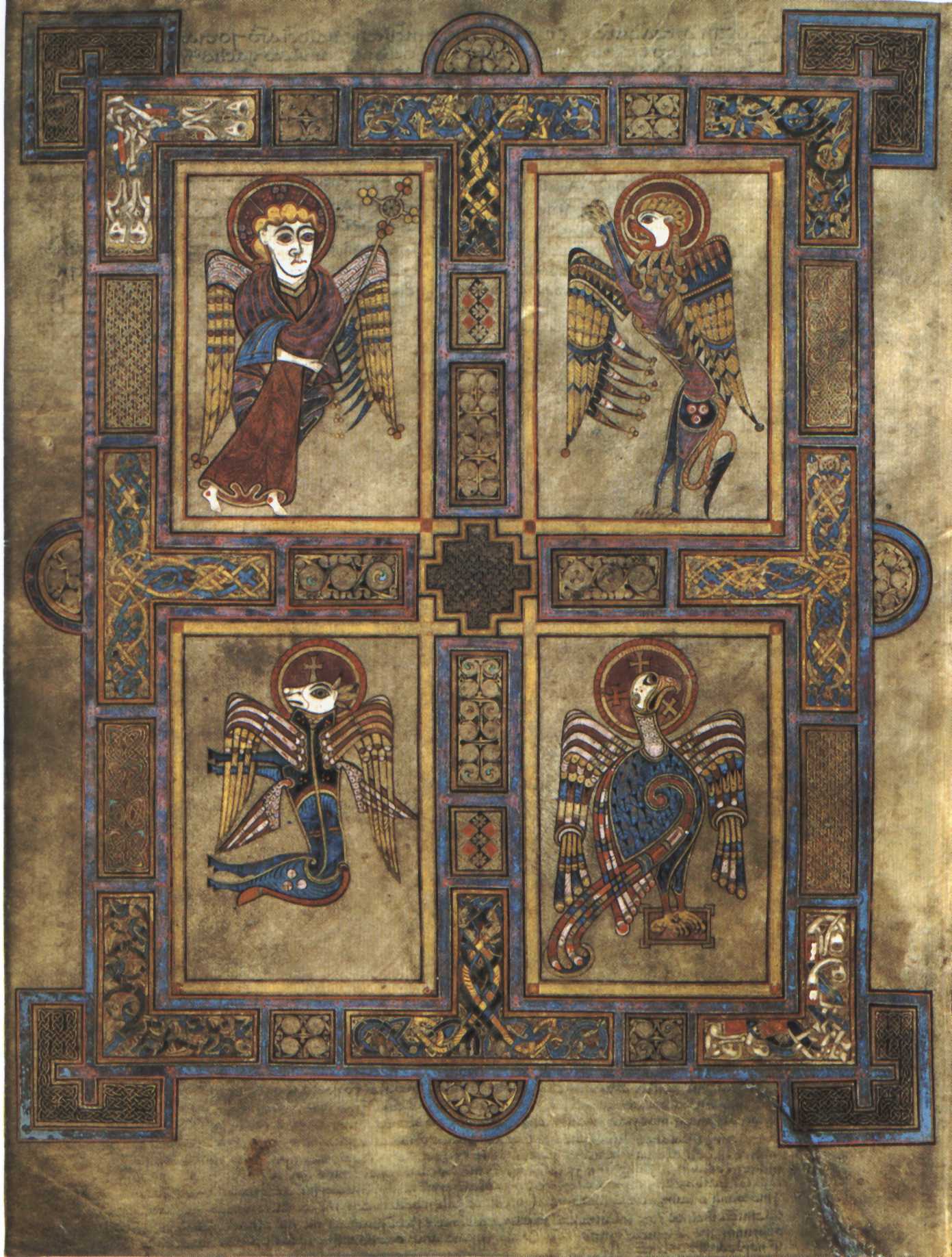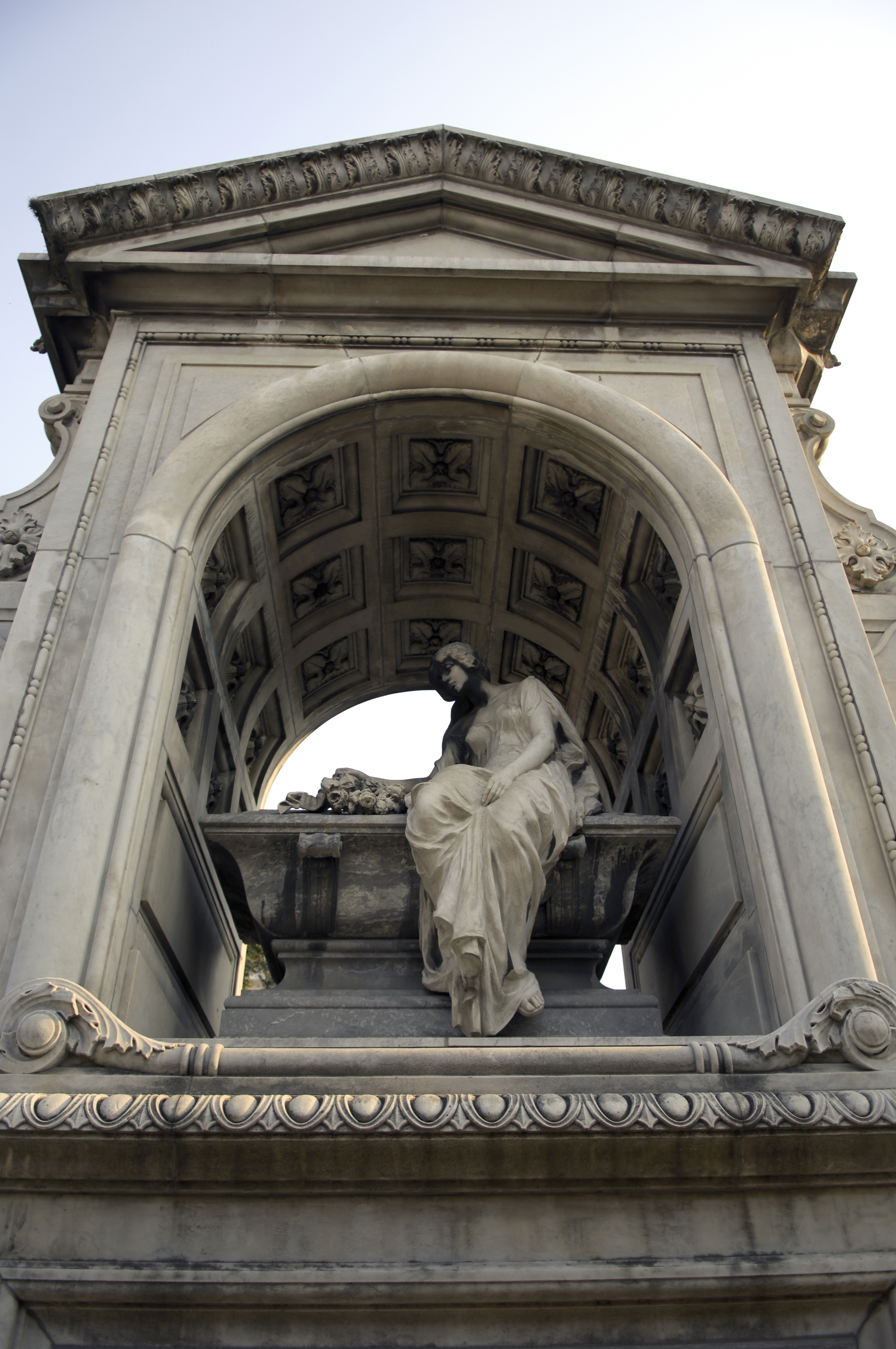|
Santo Domingo, Soria
Santo Domingo de Soria is a Romanesque-style, Roman Catholic church in Soria, Castile and León, Spain. History It was built in the late 12th century above a pre-existing church dedicated to San Tomé, although it was partially renovated in the following centuries, including the century transept and choir area, added in the 16th century when a Dominican convent was founded annexed to the church. It has a façade with two orders of arcades at the sides of the portal, which is surmounted by a rose window. The portal has an elaborated archivolt with Biblical characters and scenes, including the 24 Elders of the Apocalypse, the Massacre of the Innocents, the Youth, the Passion and the death of Christ. The tympanum has representations of the God the father sitting with the Child, four angels with the symbols of the Evangelists, the prophet Isaiah and the Virgin Mary. The capitals on the jambs of the entry feature biblical scenes from the Genesis and the life of Christ. The interior ... [...More Info...] [...Related Items...] OR: [Wikipedia] [Google] [Baidu] |
Soria
Soria () is a municipality and a Spanish city, located on the Douro river in the east of the autonomous community of Castile and León and capital of the province of Soria. Its population is 38,881 ( INE, 2017), 43.7% of the provincial population. The municipality has a surface area of 271,77 km2, with a density of 144.97 inhabitants/km2. Situated at about 1065 metres above sea level, Soria is the second highest provincial capital in Spain. Although there are remains of settlements from the Iron Age and Celtiberian times, Soria itself enters history with its repopulation between 1109 and 1114, by the Aragonese king Alfonso I the Battler. A strategic enclave due to the struggles for territory between the kingdoms of Castile, Navarre and Aragon, Soria became part of Castile definitively in 1134, during the reign of Alfonso VII. Alfonso VIII was born in Soria, and Alfonso X had his court established when he received the offer to the throne of the Holy Roman Empire. In Soria ... [...More Info...] [...Related Items...] OR: [Wikipedia] [Google] [Baidu] |
Spain
Spain, or the Kingdom of Spain, is a country in Southern Europe, Southern and Western Europe with territories in North Africa. Featuring the Punta de Tarifa, southernmost point of continental Europe, it is the largest country in Southern Europe and the fourth-most populous European Union member state. Spanning across the majority of the Iberian Peninsula, its territory also includes the Canary Islands, in the Eastern Atlantic Ocean, the Balearic Islands, in the Western Mediterranean Sea, and the Autonomous communities of Spain#Autonomous cities, autonomous cities of Ceuta and Melilla, in mainland Africa. Peninsular Spain is bordered to the north by France, Andorra, and the Bay of Biscay; to the east and south by the Mediterranean Sea and Gibraltar; and to the west by Portugal and the Atlantic Ocean. Spain's capital and List of largest cities in Spain, largest city is Madrid, and other major List of metropolitan areas in Spain, urban areas include Barcelona, Valencia, Seville, ... [...More Info...] [...Related Items...] OR: [Wikipedia] [Google] [Baidu] |
Romanesque Architecture
Romanesque architecture is an architectural style of medieval Europe that was predominant in the 11th and 12th centuries. The style eventually developed into the Gothic style with the shape of the arches providing a simple distinction: the Romanesque is characterized by semicircular arches, while the Gothic is marked by the pointed arches. The Romanesque emerged nearly simultaneously in multiple countries of Western Europe; its examples can be found across the continent, making it the first pan-European architectural style since Imperial Roman architecture. Similarly to Gothic, the name of the style was transferred onto the contemporary Romanesque art. Combining features of ancient Roman and Byzantine buildings and other local traditions, Romanesque architecture is known by its massive quality, thick walls, round arches, sturdy pillars, barrel vaults, large towers and decorative arcading. Each building has clearly defined forms, frequently of very regular, symmetrical ... [...More Info...] [...Related Items...] OR: [Wikipedia] [Google] [Baidu] |
Roman Catholic
The Catholic Church (), also known as the Roman Catholic Church, is the largest Christian church, with 1.27 to 1.41 billion baptized Catholics worldwide as of 2025. It is among the world's oldest and largest international institutions and has played a prominent role in the history and development of Western civilization. O'Collins, p. v (preface). The church consists of 24 ''sui iuris'' (autonomous) churches, including the Latin Church and 23 Eastern Catholic Churches, which comprise almost 3,500 dioceses and eparchies around the world, each overseen by one or more bishops. The pope, who is the bishop of Rome, is the chief pastor of the church. The core beliefs of Catholicism are found in the Nicene Creed. The Catholic Church teaches that it is the one, holy, catholic and apostolic church founded by Jesus Christ in his Great Commission, that its bishops are the successors of Christ's apostles, and that the pope is the successor of Saint Peter, upo ... [...More Info...] [...Related Items...] OR: [Wikipedia] [Google] [Baidu] |
Castile And León
Castile and León is an Autonomous communities of Spain, autonomous community in northwestern Spain. Castile and León is the largest autonomous community in Spain by area, covering 94,222 km2. It is, however, sparsely populated, with a population density below 30/km2. While Capital of Castile and León, a capital has not been explicitly declared, the seats of the executive and legislative powers are set in Valladolid by law, and for all purposes that city (also the most populated municipality) serves as the ''de facto'' regional capital. Castile and León is a landlocked region, bordered by Portugal as well as by the Spanish autonomous communities of Galicia (Spain), Galicia, Asturias, Cantabria, the Basque Autonomous Community, Basque Country, La Rioja (Spain), La Rioja, Aragon, Castilla–La Mancha, the Community of Madrid and Extremadura. Chiefly comprising the northern half of the Meseta Central, Inner Plateau, it is surrounded by mountain barriers (the Cantabrian Mount ... [...More Info...] [...Related Items...] OR: [Wikipedia] [Google] [Baidu] |
Dominican Order
The Order of Preachers (, abbreviated OP), commonly known as the Dominican Order, is a Catholic Church, Catholic mendicant order of pontifical right that was founded in France by a Castilians, Castilian priest named Saint Dominic, Dominic de Guzmán. It was approved by Pope Honorius III via the papal bull on 22 December 1216. Members of the order, who are referred to as Dominicans, generally display the letters ''OP'' after their names, standing for , meaning 'of the Order of Preachers'. Membership in the order includes friars, nuns, Religious sister (Catholic), active sisters, and Laity, lay or secular Dominicans (formerly known as Third Order of Saint Dominic, tertiaries). More recently, there have been a growing number of associates of the religious sisters who are unrelated to the tertiaries. Founded to preach the The gospel, gospel and to oppose heresy, the teaching activity of the order and its scholastic organisation placed it at the forefront of the intellectual life of ... [...More Info...] [...Related Items...] OR: [Wikipedia] [Google] [Baidu] |
Rose Window
Rose window is often used as a generic term applied to a circular window, but is especially used for those found in Gothic cathedrals and churches. The windows are divided into segments by stone mullions and tracery. The term ''rose window'' was not used before the 17th century and comes from the English flower name rose. The name "wheel window" is often applied to a window divided by simple spokes radiating from a central boss or opening, while the term "rose window" is reserved for those windows, sometimes of a highly complex design, which can be seen to bear similarity to a multi-petalled rose. Rose windows are also called "Catherine windows" after Saint Catherine of Alexandria, who was sentenced to be executed on a spiked breaking wheel. A circular window without tracery such as are found in many Italian churches, is referred to as an ocular window or Oculus (architecture), oculus. Rose windows are particularly characteristic of Gothic architecture and may be seen in all th ... [...More Info...] [...Related Items...] OR: [Wikipedia] [Google] [Baidu] |
Archivolt
An archivolt (or voussure) is an ornamental Molding (decorative), moulding or band following the curve on the underside of an arch. It is composed of bands of ornamental mouldings (or other architectural elements) surrounding an arched opening, corresponding to the architrave in the case of a rectangular opening. The word is sometimes used to refer to the under-side or inner curve of the arch itself (more properly, the ''intrados''). Most commonly archivolts are found as a feature of the arches of church Portal (architecture), portals. The mouldings and sculptures on these archivolts are used to convey a Theology, theological story or depict religious figures and ideologies of the church in order to represent the gateway between the Sacredness, holy space of the church and the external world. The presence of archivolts on churches is seen throughout history, although their design, both architecturally and artistically, is heavily influenced by the period they were built in and th ... [...More Info...] [...Related Items...] OR: [Wikipedia] [Google] [Baidu] |
24 Elders Of The Apocalypse
The Twenty-Four Elders are figures from the Book of Revelation who appear in the ''Revelations'' 4, 5, 7, 11 and 19 of the Christian Bible; in white robes and golden crowns they on sit with musical instruments on thrones before God during the Apocalypse and praise and worship him. Religious scholars have pointed out the thrones indicate that these are beings of power and authority in Heaven, the crowns indicate that their faith has been tested and the white robes indicate that they are clothed in righteousness. They are described in the King James Bible, Book of Revelation 4 as: :4 And round about the throne were four and twenty seats: and upon the seats I saw four and twenty elders sitting, clothed in white raiment; and they had on their heads crowns of gold. :10 The four and twenty elders fall down before him that sat on the throne, and worship him that liveth for ever and ever, and cast their crowns before the throne, saying, :11 Thou art worthy, O Lord, to receive glory and ... [...More Info...] [...Related Items...] OR: [Wikipedia] [Google] [Baidu] |
Barrel Vault
A barrel vault, also known as a tunnel vault, wagon vault or wagonhead vault, is an architectural element formed by the extrusion of a single curve (or pair of curves, in the case of a pointed barrel vault) along a given distance. The curves are typically circular in shape, lending a semi-cylindrical appearance to the total design. The barrel vault is the simplest form of a vault: effectively a series of arches placed side by side (i.e., one after another). It is a form of barrel roof. As with all arch-based constructions, there is an outward thrust generated against the walls underneath a barrel vault. There are several mechanisms for absorbing this thrust. One is to make the walls exceedingly thick and strong – this is a primitive and sometimes unacceptable method. A more elegant method is to build two or more vaults parallel to each other; the forces of their outward thrusts will thus negate each other. This method was most often used in construction of churches, where sev ... [...More Info...] [...Related Items...] OR: [Wikipedia] [Google] [Baidu] |
Psaltery
:''See Rotte (psaltery) for medieval harp psaltery & Ancient Greek harps for earlier psalterion'' A psaltery () (or sawtry, an archaic form) is a fretboard-less box zither (a simple chordophone) and is considered the archetype of the zither and dulcimer. Plucked keyboard instruments such as the harpsichord were also inspired by it. Its resonance box is usually trapezoidal, rectangular or in the form of a "pig's head" and often richly decorated. Etymology The psaltery of Ancient Greece ('' epigonion'') was a harp-like stringed instrument. The word ''psaltery'' derives from the Ancient Greek ψαλτήριον (''psaltḗrion''), "stringed instrument, psaltery, harp" and that from the verb ψάλλω (''psállō''), "to touch sharply, to pluck, pull, twitch" and in the case of the strings of musical instruments, "to play a stringed instrument with the fingers, and not with the plectrum." The psaltery was originally made from wood, and relied on natural acoustics for sound prod ... [...More Info...] [...Related Items...] OR: [Wikipedia] [Google] [Baidu] |
Rotte (psaltery)
:''See Rotte (lyre) for the medieval lyre, or Rote for the fiddle'' During the 11th to 15th century A.D., rotte (German) or rota (Spanish) referred to a triangular psaltery illustrated in the hands of King David and played by jongleurs (popular musicians who might play the music of troubadours) and cytharistas (Latin word for a musician who plays string instruments). Besides being played in popular music, the church may have used them as well; a letter from Cuthbert, Abbot of Jarrow, England survives, in which he asks an archbishop to send him a ''cytharista'' to play the ''rotta''. The instruments least 10 strings on each side and were held like a harp in front of the musician. Rottes were also described as having 17 stings and 22 strings on each side. The playing position was different from other psalteries, as the Rotte might be held like a harp, leaned sideways (flat against the musician's chest), or rested on the lap. Two styles of rotte have been inferred from images: the f ... [...More Info...] [...Related Items...] OR: [Wikipedia] [Google] [Baidu] |







